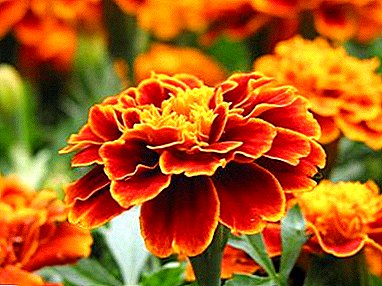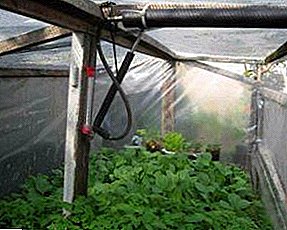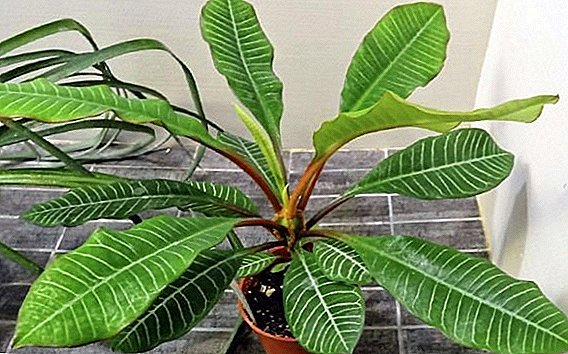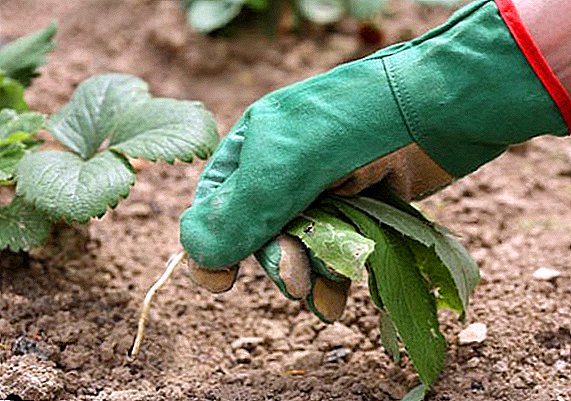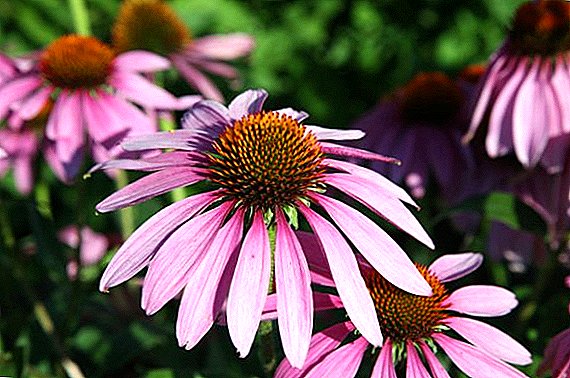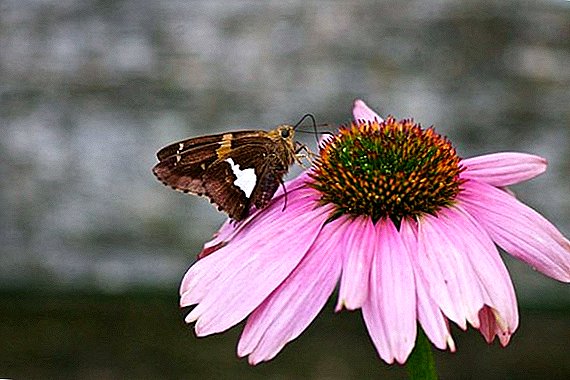 Echinacea purpurea is a hardy plant that is famous for its healing properties. Among the other advantages of the flower is its unpretentiousness in the period of growth. Consider the features of Echinacea purpurea, if planting and caring for her are made at the cottage.
Echinacea purpurea is a hardy plant that is famous for its healing properties. Among the other advantages of the flower is its unpretentiousness in the period of growth. Consider the features of Echinacea purpurea, if planting and caring for her are made at the cottage.
Botanical description
Herbaceous perennial came to us from North America, where since ancient times was revered for healing qualities. Its height is from 50 to 120 cm.
From a short many-headed rhizome straight reddish stalks are started. The stem leaves of the egg-shaped form are slightly lowered, with points pointed at the edges. The bottom sheets are oblong and rigid, with small irregularities, assembled into a socket.
The large apical basket (13–15 cm in diameter) is distinguished by the central tubes of red-brown color and purple petals, reaching 4 cm in length. The flowering period begins in the second year and lasts 2-2.5 months (from July to the first weeks of autumn).
Important! Juice obtained from fresh inflorescences accelerates wound healing. With this treatment, blood clots faster.At the end of summer and until mid-autumn, Echinacea bears fruit, giving off grayish-brown achenes.
Grow it seedlings or sowing on an open area. The plant loves light, but it is resistant to frost. Especially well taken on wet soils.
Cultivated in a continental (Central European) climate in the southern and mountainous regions.
Growth conditions
Like any other flower, echinacea in the initial period of development will require adherence to certain rules. This applies primarily to the ground and light mode.
Growing soil
There are no special requests for the hardy flower. Suitable as purchased in the store soil mixture, and the land harvested independently. But, for example, sandstone is no good.
Pink flowers of Echinacea are spectacularly combined in a flower bed with buds of derbum, Chinese astilbe, Stahis Hammelo, Liatrice and Gerardi lobelia, aconite, silvery shades of wormwood, monard and phlox of paniculata.Soil mixture should be fluff and light, well absorb moisture and pass air. Pre-disinfection also does not hurt: the substrate can be treated with a weak solution of potassium permanganate (0.5 grams of permanganate per 1 liter of water).

Did you know? Europeans met this flower in the 17th century. For more than two centuries, it was considered to be purely decorative, and it was only in the 1870s that they paid attention to properties that were beneficial to human health.Another radical, but not always effective method of preparation is to leave a bag or cassettes with earth at minus temperatures for a week and a half. However, with the usual soil, taken from the cottage, this measure may be useless (it is better to handle the solution).
Lighting Requirements
For normal development will require sunlight. At the stage of growing seedlings often put fluorescent lamps for additional lighting. Conventional, albeit powerful, light bulbs are not always suitable here.
Shoots and young (up to 1 year) plants in our conditions hardly tolerate shade, so the neighboring flowers should not cover Echinacea. Yes, and adult plants is better to allocate a separate place in the country.
The shape of the convex flowers of echinacea will be combined with flat, umbrella inflorescences of stonecrop, stevia, spherical inflorescences of onions.
Planting echinacea
Having decided to engage in the cultivation of a useful flower, many resort to the tried and tested method - seedlings. We learn what to do in this case.
Growing from seed
The most suitable time for sowing is considered the end of February. This simple procedure looks like this:
- First, the seeds are cooked: because of a rather hard shell, they are soaked in water. At the same time, the seeds are wrapped in a napkin and placed on a saucer, where they are moistened. Air must penetrate there.
- When they began to "hatch", they take the container (cups, tapes, boxes) and spread the seeds into the substrate to a depth of about 5-7 mm.
- On top of the hole lightly sprinkled with sand (a layer of 1 mm), followed by hydration with a spray bottle. It is not necessary to fill up with soil.
- It remains to cover the container with a film and put in a warm place.
Important! Seeds are often lightly pressed with a match. You can do this with your fingers, but without skill, you can deepen the planting material too much.Echinacea purpurea, as well as its cultivation, has one feature in terms of temperature: shoots will appear even at + 13-15 ° C (whereas for many hybrids this is simply disastrous). The seedlings also tolerate room temperature well.
Watering is reduced to spraying barely dried out soil, but not abundant. Sometimes the film is opened for a while, so that the earth breathes (if the pots are near the battery or other heat sources).
You can see the seedlings in 1-1.5 months. Their earlier appearance for our latitudes is rare.
Reproduction by dividing the bush
The method is good, especially if there is an adult bush (from 2 to 4-5 years).
Did you know? At the beginning of the twentieth century among the doctors was "echinacea boom" - the remedy was prescribed for almost all diseases. This interest has subsided with the advent of a treatment such as chemotherapy.Such a planting is done at the beginning of spring, until the base of the shoots began to harden, and the leaves did not have time to open. Catching the moment, proceed:
- The bush is dug and cut into cuttings. Each of them must have adventitious roots and at least one kidney.
- They are then placed in a liquid immunostimulant for several hours. You can speed up the process by treating the fungicide.
- Planted in light ground, root collar does not deepen (they remain at ground level). For delenok, the depth should be slightly larger than the rhizome.
Echinacea will look good in the foreground in front of stevie, fennel, red-leaved forms of barberries and a bubble fruit.With proper watering, the roots will grow in 1.5 months, then you can transfer the plant to the open area. Be prepared for the fact that the first year of such echinacea will be weak, and she will need enhanced care. But then she will please with bright petals.
Growing medicinal plants in open ground
In addition to the seedling method with further transplantation, many gardeners grow a useful plant in a simpler way, sowing its seeds immediately to the ground. But the weather can adjust the plans, and then have to go back to the seedlings.
Important! For the northern regions, this method is unlikely to work. And in areas with a temperate climate, there is always the risk of repeated frosts.The sowing scheme is simple - with an interval of 30 cm and at a depth of 0.5-1 cm (whereas mature seedlings need pits of 10-15 cm). The hole is covered with a thin layer of garden soil, and after disembarking it is immediately sprayed and covered with film or agrofibre.
For adult plants, the depth of the fossa is made with a small margin for the root.
Watering features
Echinacea needs frequent and abundant watering. It is best to moisten the soil in the evening. For all its unpretentiousness, the plant is quite sensitive to dehydration and drought (the reason is shallow root).
Weeding and soil care
Mandatory timely cleaning of weeds. Often Echinacea assign a place bordering the neighboring areas from which weeds can penetrate.
Healthy soil or loam often does not need frequent seasonal feeding. For sandy soils, supplements are practiced in the form of ground bedding or humus.
Did you know? Indians applied echinacea flowers to snakebite sites. The roots then dried rarely, eating fresh.Here it is important not to harm the plant - it is better to chop the humus at the roots. If this is not done, then with rare watering this fertilizer can burn out the soil and dry the rhizome.
Do not forget about the periodic loosening, which will ensure the flow of air to the roots.
Feeding rules
Echinacea need to organize annual feeding. For the best growth they are made twice - in the spring and after flowering. In the second year and then they pour ash with rotted compost for more lush flowering.
There is an important point: if the flower is needed to remove the healing material, then use only organic matter. Nitrogen, potash, phosphate fertilizers are not suitable for such purposes, like any other mineral chemistry. Poor soil will take and compost, and you do not harm health.
Pruning
In late autumn, the stems are cut, and the root of the neck is easily mulched with compost. If the autumn was warm, then you will notice that the seeds ripen in the first inflorescences.
Important! Echinacea formulations help with chronic fatigue and depression. Mandatory medical consultation.For safety it is better to cover young plants with leaves. Older instances do not need this.

Harvesting and drying of therapeutic raw materials
Biennial plants are already suitable for therapeutic purposes.
Leaves, flowers and stems are collected during flowering. At this time, they accumulate the maximum amount of nutrients. They are advised to cut off in the morning when the dew is completely gone.
Store such material in dark, dry places (in the attic or under a shed). Flowers can be dried separately, spreading them on the litter in one layer.
At the end of the seasonal growing season, in the fall, gather roots. They are washed, remove diseased processes. For drying any dry place is suitable. You can even put in the oven, putting the temperature no higher than 60 ° C.
In your garden, you can grow medicinal plants such as basil, double-leaf Lyubka, wild rose, wormwood, zizifus, catnip, linden, medunitsya, mint, lemon balm, medicinal sage, lovage.
All these raw materials retain healing properties for two years. It is actively used for the manufacture of various tinctures, ointments, and even as an ingredient for firming tea.
Echinacea purpurea grown from seeds, after harvesting helps with:
- colds and flu;
- blood poisoning;
- disorders of the urinary tract and liver function;
- diabetes;
- presence of heavy metals in the body;
- skin lesions and burns.
Did you know? In the 18th century, Echinacea stalks were used to treat race horses.
Before taking any folk remedies, think about possible contraindications. They have Echinacea:
- leukemia;
- atherosclerosis;
- connective tissue disorders;
- tuberculosis;
- any autoimmune diseases.
We have seen that purple echinacea is not only pleasing to the eye, but can also be beneficial if we approach the treatment wisely. There are no difficulties in growing it, and minimum skills are needed - everyone will cope. I wish you success!




